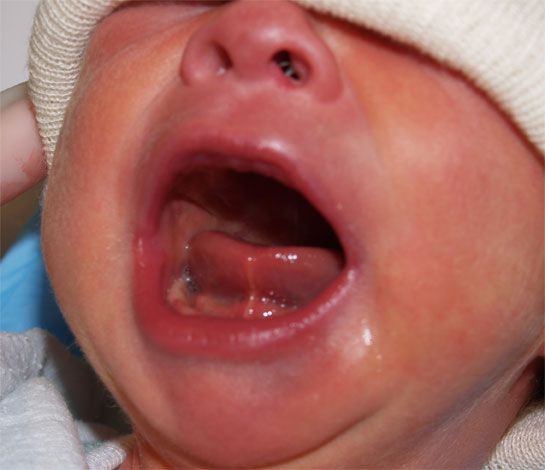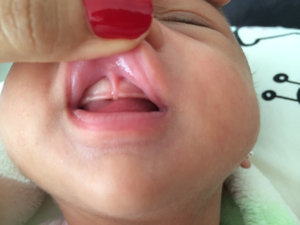Babies are born with an increasing prevalence of lip and/or tongue tie (aka tethered oral tissues or TOTS). While it would seem that this would affect only matters of feeding, these ties create pulling in the soft tissues to which they attach. This tugging can affect almost every aspect of a small infant’s life: tightness in their jaw and cheek muscles means baby sucks in extra air which can look like reflux, digestive issues, and excessive crying or colic. The tethering of the tissues can affect the shape of the inner or outer parts of her head and can cause restrictions in the airway (this can look like mouth breathing, sinus/adenoid issues, and baby snoring). Your baby may prefer to turn their head only one way (torticollis) which can create imbalances in the head (plagiocephaly) if he or she is constantly lying in the same position.
How do I know if my baby has tongue or lip ties? TOTS can look like this  :
:

Baby's lip may tuck under while at the breast or sucking on a bottle.The other big telltale signs (other than the fussiness, latch problems, and asymmetries in infants) look like a hyper gag reflex, and LOTS of hiccuping.
What can I do if my baby has ties? First of all, it is best to see a pediatric dentist specializing in TOTS or a gentle ENT for a diagnosis, and release of the tethered oral tissues.
How do I help my baby prepare for the revision and reorganize sucking after? Baby needs body work to help integrate the changes after the tie has been released. The sudden release of a very restricted area creates more open space and potentially some instability in that area. This area benefits greatly from passive reorganization, particularly in the case of latch problems, torticollis, or lots of spinal arching. We specialize in very gentle but specific adjustments to the upper neck that can help restore normal motion. Parents are amazed at how gentle this is, similar to checking for the ripeness of a tomato! In addition to these crucial adjustments, Dr. Erin is skilled in craniosacral therapy, which she uses to help your baby’s head and soft tissues surrounding it to open up. Dr. Erin loves to empower parents to help their babies. She will teach you stretches and exercises that you can do at home to balance your baby’s asymmetry.
What if I choose not to or my provider doesn’t want to release my baby’s lip or tongue ties? Each mom knows her child best. Weight gain for infants, and the comfort of mom and baby with feeding are most crucial when weighing whether or not to release. If baby and mom are both comfortable, other factors to consider include future dental work, the degree to which baby’s airway is open, and baby’s baseline level of tension.
We would love to see if we can help you acclimate to your growing family by helping baby find more comfort!